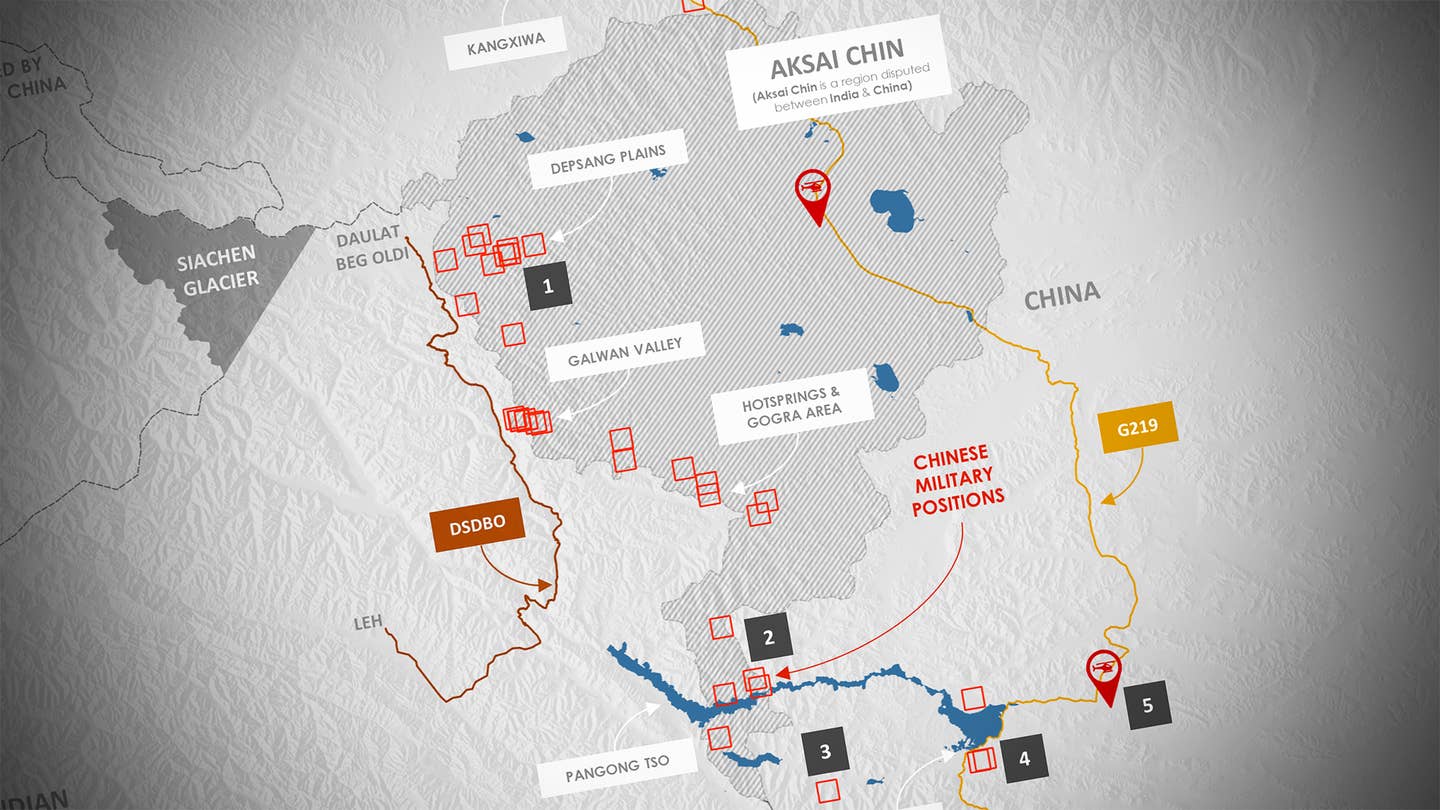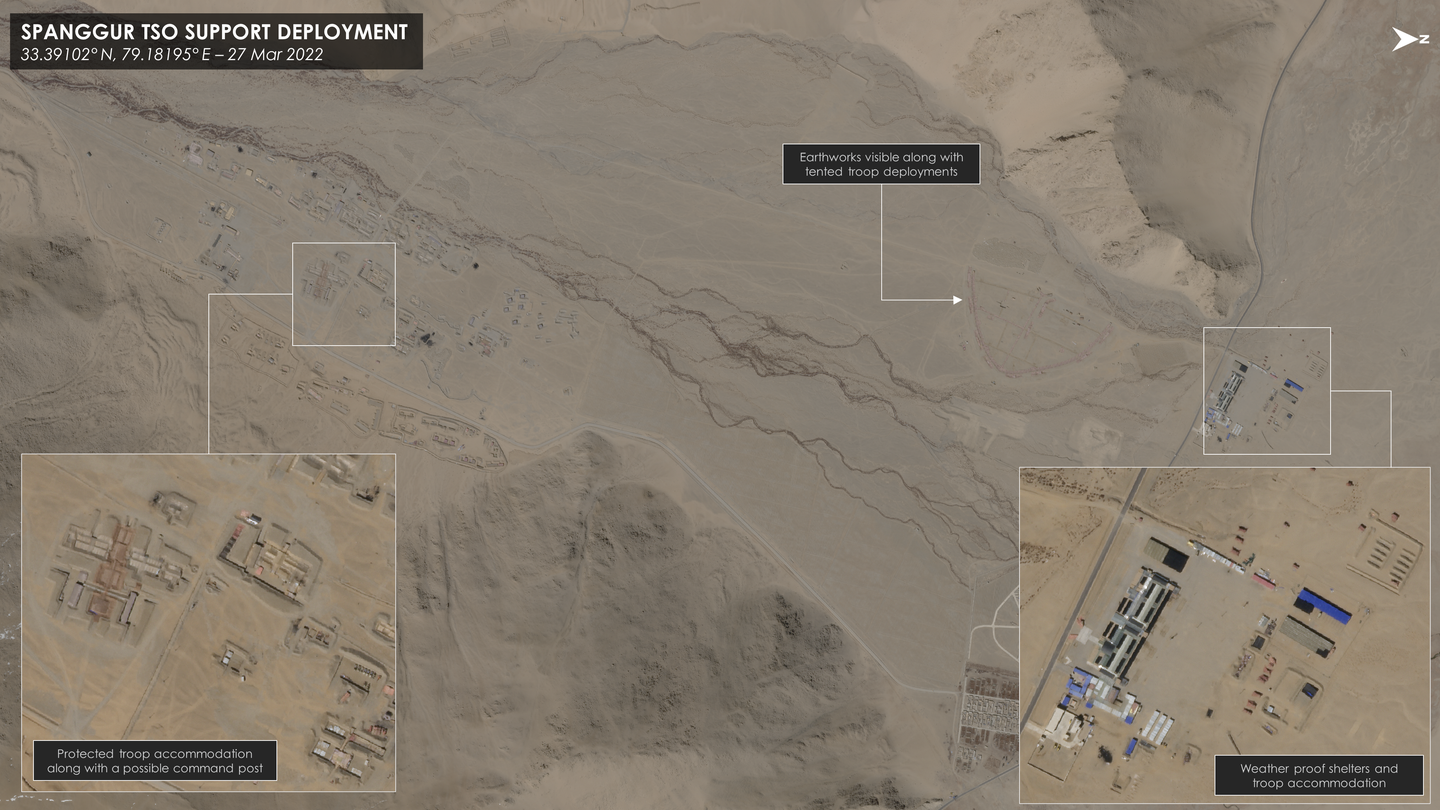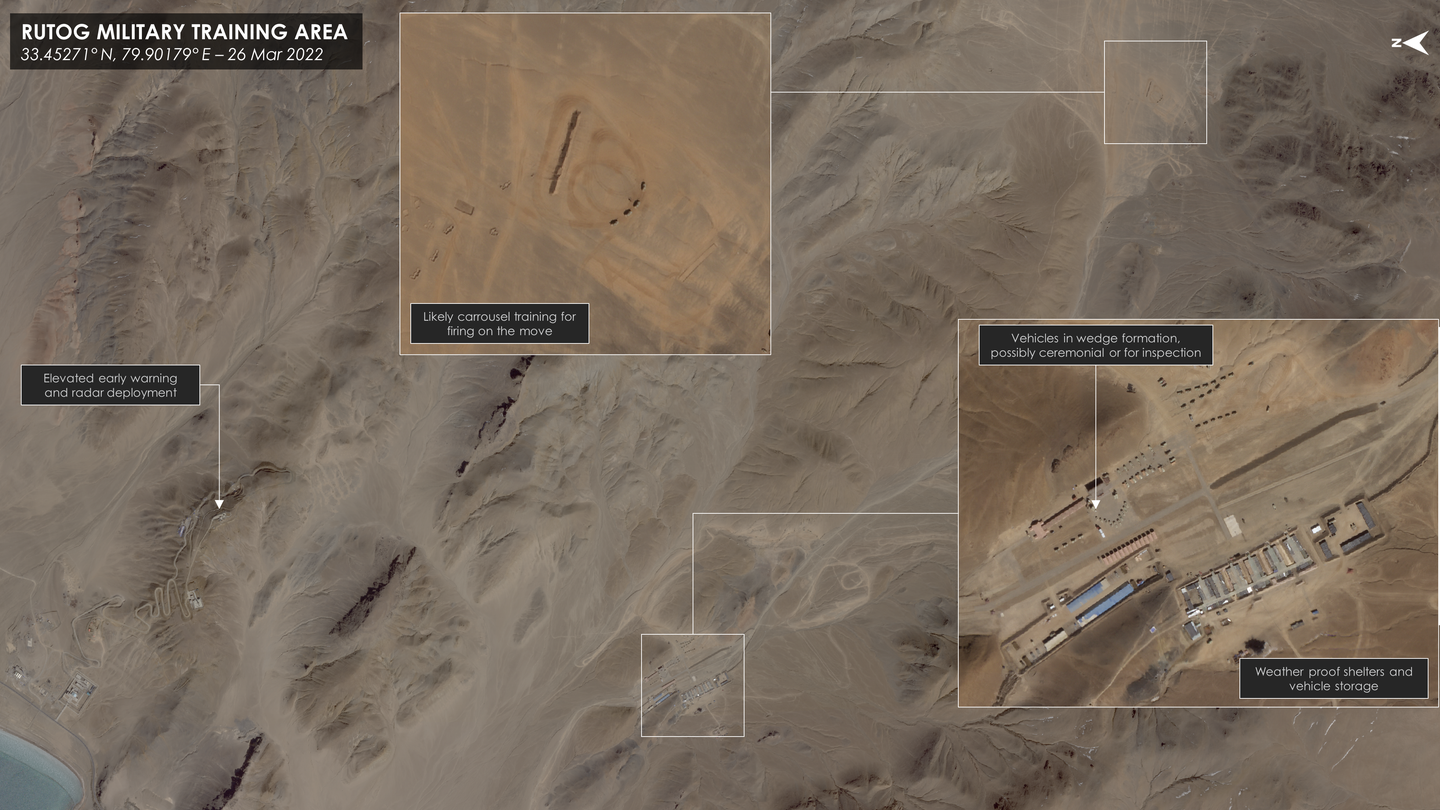DETRESFA

Two years have passed since the height of the most recent flare-up in the border crisis between China and India that started in May 2020. The event saw lethal melee combat over Aksai Chin, which the Chinese claim as a part of Xinjiang and India claims as a part of Ladakh, Jammu and Kashmir. Both India and China reported casualties as a result of a June 2020 altercation in this region's Galwan Valley. The crisis itself ended through a number of limited withdrawals of frontline positions on both sides. But now, two years later, the overall strategic picture is one of remarkable Chinese military buildup and encroachment.
Being one of the largest disputed areas between India and China, Aksai Chin sits adjacent to the Kashmir region, another turbulent border for India due to its overlapping claim on the region with Pakistan. Sitting at 38,000 square kilometers, Aksai Chin is a cold, arid, and largely uninhabited desert just a little bigger than Maryland. The area has been long disputed between the two with China extending its first military grab over the region after the Sino-Indo war of 1962. Four decades passed with both countries regularly entering into minor scuffles in the region, but 2020 witnessed a complete change in tempo, pushing two nuclear-armed neighbors into a rapid escalation. Some reports have suggested that China’s aggression came as a result of a new road – the Darbuk–Shyok–Daulat Beg Oldi Road, or DSDBO – that India was building in the region. Another possible catalyst linked to the conflict was a move by India to change the status of Jammu & Kashmir, redrawing maps and borders which included the disputed area — a move China has regularly voiced opposition to.
As the crisis dropped from the headlines following the initial de-escalation, no further progress was made in negotiations. Chinese and Indian troops remain just kilometers apart while steadily increasing their military capacity. Through the crisis, China managed to effectively take control of Aksai Chin — in a practical military sense, this is a departure from its previous disputed status — and has heavily militarized the entire region around it.
During the border crisis in 2020, China established improvised positions at key locations along the edges of its own territorial claim in the region. Chinese forces established tent camps in the Galwan Valley, occupied critical patrol points, sent forces to camp atop mountain ranges along high altitude lakes and set up new bases in open plains. Negotiations during the crisis itself led China to abandon a small minority of these improvised frontline positions, but over the next two years, the vast majority of them developed into permanent all-weather military encampments.
The strength that China has rapidly developed along these borders will severely constrain India’s ability to ever recover access to the Aksai Chin region. Despite the public appearance of the crisis being settled in a Chinese withdrawal, this withdrawal has remained negligible compared to the scale of the territory that China has militarized. As such, China has achieved a form of territorial expansion by bringing Aksai Chin from a disputed status to a de facto militarily occupied status.
India has, of course, not been entirely passive throughout the course of the crisis and the two years that have followed. Initially, its stern response to Chinese expansions into the Galwan Valley quite literally pushed back the Chinese efforts to establish new positions, but its risk-averse approach did eventually allow the Chinese military to dig in at Aksai Chin.
The main Indian response has come outside of Aksai Chin itself, within the undisputed bordering territories of India, and has focused on building up a capacity for aerial combat and reconnaissance along with the redistribution of forces along its northern border. While China built up its military capacity within Aksai Chin, India has been upgrading and adding to its air bases outside of, but near Aksai Chin. New armaments have also made it into the Indian inventory, such as the French-made Rafale multi-role fighter aircraft, as well as the possible acquisition of U.S.-made MQ-9B Reaper unmanned aerial vehicles that would enhance India’s ability to monitor Chinese activities in Aksai Chin, and if needed to strike against them if a conflict were to break out.
“This sort of development would have been a land warfare planner’s nightmare, but it offers India a unique advantage now, in the form of a target-rich environment for the Indian Air Force, the same air force that has, in the course of the last few years, replaced the army as the primary response to serious cross border threats,” according to Iyer-Mitra. “Unfortunately, the progress on the Chinese side, in his opinion, solidifies the fluid line of actual control into an actual border, one that will be more prone to friction. But on the bright side, this semi-formally ends the 'salami-slicing' the Chinese resorted to till around 2013.”
Salami-slicing refers to a well-known Chinese strategy for territorial expansion, where, with the use of small provocations and challenges separated over time, China tries to achieve a much larger snowballing goal.
Choosing a path of stability and de-escalation has also allowed India to nurture close relationships with strategic partners in the developed world to help balance against or contain Chinese power on a global level. The Quadrilateral Security Dialogue, known commonly as “the Quad,” that brings India together with the United States, Australia, and Japan (as well as possibly South Korea and Vietnam’s role as part of the so-called “Quad Plus”) is one of the main ways in which India tries to build such a diplomatic alliance. Coordinating with countries that all share concerns over Chinese power projection may allow India to be part of a higher-level strategic effort to counterbalance against China. Still, that doesn’t mean these burgeoning alliances will directly impact the situation in Akai Chin.
The most critical manner in which China has in fact managed to establish its undisputed control over the Aksai Chin region is evidenced by the evolution of China’s frontline positions. While initially composed of small outposts and then joined by temporary tent camps during the 2020 face-off, these positions have now evolved into permanent bases with cold weather shelters.
At the Depsang Plains for example, at the northern end of the disputed Aksai Chin region, China used to maintain an observational presence. Today, this area boasts a large military position composed of infantry shelters and ammunition storage facilities, as well as tanks and artillery systems. The Chinese presence at the Depsang Plains evolved from a limited mission to a permanent deployment of a large combat-capable force that would present serious challenges for India to dislodge from its positions.
At Galwan Valley and Hot Springs, Chinese troops were in fact forced to withdraw following skirmishes with Indian troops and ensuing negotiations in 2020. Even at these locations of the so-called “mutual withdrawals” just a single kilometer removed from their initial positions, Chinese forces have established large permanent bases supported by solar panels to provide them with energy and modern roads to resupply them.
 PHOTO © 2022 PLANET LABS INC. ALL RIGHTS RESERVED. REPRINTED BY PERMISSION
PHOTO © 2022 PLANET LABS INC. ALL RIGHTS RESERVED. REPRINTED BY PERMISSIONChina does maintain some rather rudimentary temporary positions in the Spanggur Lake area (just south of Pangong Lake), but even these positions are directly supported by permanent military positions that China developed at Pangong Lake and the even larger military support positions deeper into China at Rutog.
 PHOTO © 2022 PLANET LABS INC. ALL RIGHTS RESERVED. REPRINTED BY PERMISSION
PHOTO © 2022 PLANET LABS INC. ALL RIGHTS RESERVED. REPRINTED BY PERMISSIONChina’s ability to claim undisputed control over Aksai Chin is not based solely on its ability to establish permanent military positions on the border of the disputed territory. Perhaps even more important is the vast network of large logistical nodes and support bases that China established within the disputed region, and the tremendous effort it has gone through to connect these and its frontline positions by building new roads. Where China in the past maintained a logistics network that could support the presence of several hundred Chinese troops on the frontlines of its territorial claims in Aksai Chin, this upgraded infrastructure and support network now allows it to reinforce many thousands of troops simultaneously.
This effort may seem easier than it really is, but in order to effectively connect all these positions and support bases to China’s existing military lines of communication, it has had to effectively tame the geography of Aksai Chin.
This means, for example, taming the riverbed in the many valleys between mountain ranges, to guarantee year-round mobility even when the rivers are in spate. By constructing this brand new road network, interspaced with large arterial support bases behind the frontline, China effectively turned what used to be a long five-hour journey into just a one or two-hour trip.
China has also not limited its logistical expansion into Aksai Chin to ground transport and has expanded its logistics into the third dimension by constructing a number of large heliports inside and nearby Aksai Chin. Prior to the 2020 crisis, small Chinese observation posts would sometimes have a small helipad nearby, but the new disposition includes the permanent deployment of entire helicopter squadrons at key logistical nodes to facilitate the rapid movement of troops or supplies when needed. The redevelopment and expansion of airpower on China’s western border is not only limited to Aksai Chin, the pattern has been observed across the Tibetan Plateau indicative of a larger vertical lift network that is rapidly taking shape. You can read all about this reality and our analysis of it in past features linked here and here.
The expansion of China’s forward deployments and logistical support even expands beyond the Aksai Chin region itself. Since the beginning of the 2020 crisis, China has erected veritable military cities from the empty desert. These immense bases directly support China’s ability to maintain troop presence within Aksai Chin, and offer it the ability to rapidly surge its military presence in the area during future crises.
At Pangong Lake, for example, new roads – and a bridge across the lake just outside of India’s territorial claim – reach all the way around the lake to the town of Rutog where large military facilities now dominate the landscape.
These facilities provide for a permanent deployment of Chinese forces, as well as frequent rotations of training exercises that allow Chinese military units to even better prepare for potential conflict in this region and especially at extreme altitudes that are a staple of it. The same is true for other regions, where in the North, the logistical connections draw all the way to China’s Hotan Air Base, and in the south, Chinese forward positions at Demchok are supported by connections to military facilities in Gar County and the Ngari Gunsa air bases.
“In Aksai Chin, China has largely replicated its success of gaining de facto control of disputed territory in the waters of the South China Sea,” Singh says. “Getting the best intelligence, surveillance and reconnaissance capabilities possible and investing in its military to deter further Chinese provocations is vital.”
“Beijing’s success with coercion and militarisation of disputed territory below the threshold of conflict can easily lead to miscalculation about what will provoke a forceful response from a neighbor and risk escalation.”
As India turns to self-reliance, Singh says, it should leverage its "willing partners, the United States, as well as Europe and Israel, can provide technology India needs right now to stay on top of the challenge from China and contribute to self-sufficiency.”
The intensity of China’s military buildup in and around Aksai Chin, which has continued effortlessly after the limited withdrawals in 2020, effectively puts it in a position where its ability to project military power into the disputed region is relatively uncontestable. Negotiations have not led to any breakthroughs for India to improve its position or access within the disputed territory.
In essence, time has been on China’s side and India now faces a (quite literal) uphill battle to restore even a semblance of control over its territorial claims in this area while it simultaneously faces similar challenges at other locations of its shared border farther East.
No comments:
Post a Comment